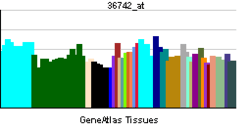TRIM15
Tripartite motif-containing protein 15 is a protein that in humans is encoded by the TRIM15 gene.[1][2][3][4]
The protein encoded by this gene is a member of the tripartite motif (TRIM) family. The TRIM motif includes three zinc-binding domains, a RING, a B-box type 1 and a B-box type 2, and a coiled-coil region. The protein localizes to the cytoplasm. Its function has not been identified. Alternate splicing of this gene results in two transcript variants encoding different isoforms.[4]
References
- ↑ Reymond A, Meroni G, Fantozzi A, Merla G, Cairo S, Luzi L, Riganelli D, Zanaria E, Messali S, Cainarca S, Guffanti A, Minucci S, Pelicci PG, Ballabio A (May 2001). "The tripartite motif family identifies cell compartments". EMBO J 20 (9): 2140–51. doi:10.1093/emboj/20.9.2140. PMC 125245. PMID 11331580.
- ↑ Goei VL, Parimoo S, Capossela A, Chu TW, Gruen JR (Mar 1994). "Isolation of novel non-HLA gene fragments from the hemochromatosis region (6p21.3) by cDNA hybridization selection". Am J Hum Genet 54 (2): 244–51. PMC 1918154. PMID 8304341.
- ↑ Gruen JR, Nalabolu SR, Chu TW, Bowlus C, Fan WF, Goei VL, Wei H, Sivakamasundari R, Liu Y, Xu HX, Parimoo S, Nallur G, Ajioka R, Shukla H, Bray-Ward P, Pan J, Weissman SM (Feb 1997). "A transcription map of the major histocompatibility complex (MHC) class I region". Genomics 36 (1): 70–85. doi:10.1006/geno.1996.0427. PMID 8812418.
- ↑ 4.0 4.1 "Entrez Gene: TRIM15 tripartite motif-containing 15".
Further reading
- Shiina T, Ota M, Shimizu S et al. (2006). "Rapid Evolution of Major Histocompatibility Complex Class I Genes in Primates Generates New Disease Alleles in Humans via Hitchhiking Diversity". Genetics 173 (3): 1555–70. doi:10.1534/genetics.106.057034. PMC 1526686. PMID 16702430.
- Gerhard DS, Wagner L, Feingold EA et al. (2004). "The Status, Quality, and Expansion of the NIH Full-Length cDNA Project: The Mammalian Gene Collection (MGC)". Genome Res. 14 (10B): 2121–7. doi:10.1101/gr.2596504. PMC 528928. PMID 15489334.
- Suzuki Y, Yamashita R, Shirota M et al. (2004). "Sequence Comparison of Human and Mouse Genes Reveals a Homologous Block Structure in the Promoter Regions". Genome Res. 14 (9): 1711–8. doi:10.1101/gr.2435604. PMC 515316. PMID 15342556.
- Strausberg RL, Feingold EA, Grouse LH et al. (2003). "Generation and initial analysis of more than 15,000 full-length human and mouse cDNA sequences". Proc. Natl. Acad. Sci. U.S.A. 99 (26): 16899–903. doi:10.1073/pnas.242603899. PMC 139241. PMID 12477932.
- Harada H, Harada Y, O'Brien DP et al. (1999). "HERF1, a Novel Hematopoiesis-Specific RING Finger Protein, Is Required for Terminal Differentiation of Erythroid Cells". Mol. Cell. Biol. 19 (5): 3808–15. PMC 84222. PMID 10207104.


